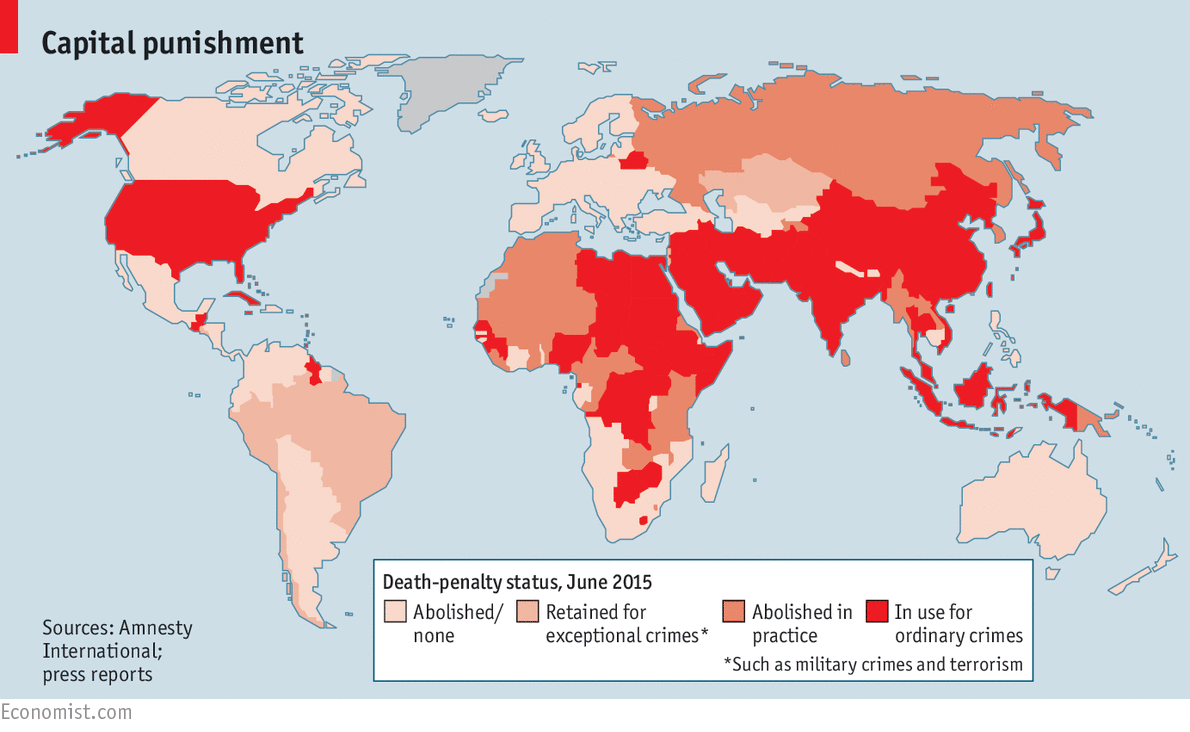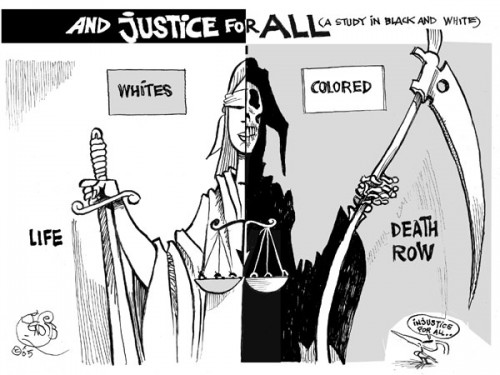The United States is one of the few industrialized, democratic nations in the world which still permits capital punishment on a state-by-state basis. Not all states have the death penalty but executions are still carried out in the United States and the punishment remains controversial.
Despite the singularity of its status internationally, the death penalty has historically been a popular policy in the United States, even though it has been hotly debated throughout US history in the legislature and the courts. This essay on death penalty will examine its legal statusin the United States, its history, and its future.
[toc]
Topics
The Future of the Death Penalty in America
Why America Has a Death Penalty
Death Penalty: Arguments and Counter-Arguments
Death Penalty Pros and Cons
[
more topics for death penalty ]
Titles
A Comparison of the Death Penalty in Different Countries and the United States
The Death Penalty Debate in the United States
The Death Penalty: Is it Just and Fair?
Death Penalty: A Legal Overview of the Death Penalty in the United States
Outline
I. Introduction
II. Body
A. Status of the Death Penalty in the United States
B. The Troubled History of the Death Penalty in the United States
C. Arguments Against the Death Penalty
D. Arguments in Favor of the Death Penalty and Counter-Arguments
III. Conclusion
Thesis Statement
Given that public opinion has increasingly turned against the death penalty in the United States, combined with the expense of capital cases and concerns about the innocence of convicted defendants, it is time for the United States to take a stand with the rest of the democratic, industrialized world community and abolish the death penalty.
Body
According to a recent poll of US voters which asked them about their views of the death penalty, support for the punishment is at a historic low. For the first time, a minority of US citizens oppose the death penalty, according to a poll by the nonpartisan Pew Research Center. Only about half of Americans (49%) now favor the death penalty for people convicted of murder, while 42% oppose it. Support has dropped 7 percentage points since March 2015, from 56% (Oliphant 2016). Support peaked in the mid-1990s, when eight-in-ten Americans (80% in 1994) favored the death penalty and fewer than two-in-ten were opposed (16%) (Oliphant 2016). Opposition to the death penalty was also vocal in the 1970s, particularly after the US Supreme Court decision Furman v. Georgia (1972) which briefly declared all death penalty statutes unconstitutional, deeming them discriminatory in the ways in which they were enforced.
The Supreme Court later found in Gregg v. Georgia (1976) that the death penalty itself was not cruel and unusual punishment, provided it was appropriately administrated and so long as its use was judicious and careful (Gregg v. Georgia, 1976 ). Post-Gregg, states with the death penalty have introduced safeguards, such as a separate process for determining if death is warranted, versus the subjects guilt alone. The existence of the death penalty at all remains controversial within America, particularly given that the United States remains relatively isolated in terms of its insistence upon permitting the death penalty amongst modern, industrialized democracies. Other nations which still permit the death penalty include China, North Korea, and Saudi Arabiahardly illustrious company in the sphere of human rights (Death penalty statistics by country, 2011).
[caption id="attachment_815" align="alignnone" width="500"]

Image Credit: The Economist http://www.deathpenaltyinfo.org/images/EconomistMap.png[/caption]
History of the Death Penalty in the United States
The history of the death penalty extends far back into history, longer than the United States has existed as an independent nation. Even in the ancient world, the death penalty was practiced. Code of King Hammurabi of Babylon codified the death penalty for twenty five different crimes, although murder was not one of them (Reggio 2014). In Europe, by the tenth century, hanging was commonly used as a means of execution and by the Middle Ages in Great Britain and the rest of Europe, prisoners were often tortured before being executed, even for relatively minor crimes or for their religious affiliations. Well into the eighteenth century, stealing small sums of money were capital offenses although by the early nineteenth century in Great Britain, only serious offenses were capital crimes. This was also true of colonial America. By 1776, most of the colonies had roughly comparable death statutes which covered arson, piracy, treason, murder, sodomy, burglary, robbery, rape, horse-stealing, slave rebellion, and often...
The US Constitution expressly forbids cruel and unusual punishments under the Eighth Amendment of the Bill of Rights.
The question of whether the death penalty is cruel and unusual has been hotly debated. It may come as a surprise that as early as the mid-nineteenth century there was a robust movement to abolish the death penalty and many states elected to do so. In 1846, Michigan abolished the death penalty, followed by Rhode Island in 1852 (Reggio 2014). The abolitionist movement was extremely influential in supporting the abolishment of capital punishment as well. However, even while many states banned the death penalty, other states began to simply search for new methods to use to execute prisoners. Between 1917 and 1955, the death penalty abolition movement again slowed. Washington, Arizona, and Oregon in 1919-20 reinstated the death penalty. In 1924, the first execution by cyanide gas took place in Nevada, when Tong war gang murderer Gee Jon became its first victim, and the electric chair, versus hanging, became more common (Reggio 2014).
Arguments Against the Death Penalty
The legal argument most frequently used to protest the death penalty is that it is cruel and unusual punishment and thus a violation of the US Constitution Bill of Rights. However, the US Supreme Court has not found the death penalty in and of itself to be a cruel and unusual punishment under the Eighth Amendment, although it has found abusive treatment within prisons to be cruel and unusual. The Supreme Court performs a so-called proportionality analysis when evaluating a punishment according to the following three tests: Consideration of the offense's gravity and the stringency of the penalty; a consideration of how the jurisdiction punishes its other criminals; and a consideration of how other jurisdictions punish the same crime (Death penalty, 2017).
Another important argument against the death penalty is its discriminatory nature. Historically, African-Americans have been executed in greater numbers than whites, even for the same offenses. The Death Penalty Information Center (DPIC) notes that while 56% of death row inmates are black or Hispanic and despite the fact that racial minorities comprise half of all murder victims nationwide, a far greater proportion (77%) of the victims in capital convictions were white, indicating that the act of an African-American or Hispanic individual murdering a white person may lead to a higher conviction rate (Love 2012). Furthermore, the humanitarian watchdog group Amnesty International notes 20% of blacks nationwide were convicted by all-white juries (Love 2012).
There is also a significant state-by-state discrepancy that can result in entirely different systems of justice being dispensed, simply depending on the location of where a crime has occurred. For example, nationally, Alabama ranks 23rd in population, but second i executions in 2011 and African-Americans are 27% of the population, yet comprise 63% of the prisoners (Love 2012). The former states of the Confederacy make up the vast majority of the states executing criminals in the US. Over three quarters of executions take place in the states of the former Confederacy (including 35% in Texas alone) with their history of racial violence, lynching and arbitrary Black Codes and Jim Crow laws, which sanctioned death for blacks for certain offenses (Love 2012).
[caption id="attachment_817" align="alignnone" width="540"]

Image Credit: No to War - http://www.notowar.com/wp-content/uploads/2011/10/death6-500x375.jpg[/caption]
The discriminatory nature of the death penalty is one of the major reasons that the US Supreme Court found the way in which the death penalty was enforced in the US to be unconstitutional in Furman v. Georgia (1972): The Court reasoned that the laws resulted in a disproportionate application of the death penalty, specifically discriminating against the poor and minorities. The Court also reasoned that the existing laws terminated life in exchange for marginal contributions to society and found no evidence of any deterrent value (Death penalty, 2017). Yet while this temporarily required states to review how their death penalty statutes were written, it merely prolonged rather than terminated the use of the death penalty in the United States, as states reviewed how death penalty cases and sentencing were administrated. In Gregg v. Georgia, the Court held the death penalty was not per se unconstitutional as it could serve the social purposes of retribution and deterrence and upheld Georgias new capital sentencing procedures, reasoning that the Georgia rules reduced the problem of arbitrary application as seen in earlier statutes given that the new death penalty was not discriminatory against African-Americans nor arbitrary as previous death penalty statues of the kind overturned in the Furman case (Death penalty, 2017). Yet the statistics still indicate that the death penalty is being administered in a discriminatory fashion.
The US Supreme Court…


 Image Credit: The Economist http://www.deathpenaltyinfo.org/images/EconomistMap.png[/caption]
Image Credit: The Economist http://www.deathpenaltyinfo.org/images/EconomistMap.png[/caption] Image Credit: No to War - http://www.notowar.com/wp-content/uploads/2011/10/death6-500x375.jpg[/caption]
Image Credit: No to War - http://www.notowar.com/wp-content/uploads/2011/10/death6-500x375.jpg[/caption]
